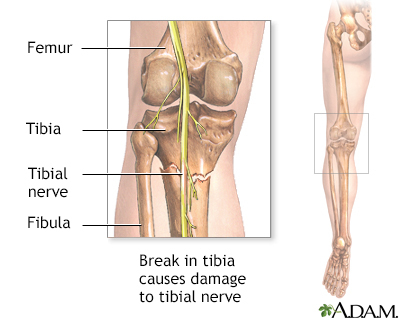Tarsal tunnel syndrome
Definition
Tarsal tunnel syndrome is a condition in which the tibial nerve is being compressed. This is the nerve in the ankle that allows feeling and movement to parts of the foot. Tarsal tunnel syndrome can lead to numbness, tingling, weakness, or muscle damage mainly in the bottom of the foot.
Alternative Names
Tibial nerve dysfunction; Posterior tibial neuralgia; Neuropathy - posterior tibial nerve; Peripheral neuropathy - tibial nerve; Tibial nerve entrapment
Causes
Tarsal tunnel syndrome is an unusual form of peripheral neuropathy. It occurs when there is damage to the tibial nerve.
The area in the foot where the nerve enters the back of the ankle is called the tarsal tunnel. This tunnel is normally narrow. When the tibial nerve is compressed, it results in the symptoms of tarsal tunnel syndrome.
Pressure on the tibial nerve may be due to any of the following:
- Swelling from an injury, such as a sprained ankle or nearby tendon
- An abnormal growth, such as a bone spur, lump in the joint (ganglion cyst), swollen (varicose) vein
- Flat feet or a high arch
- Body-wide (systemic) diseases, such as diabetes, low thyroid function (hypothyroidism), arthritis
In some cases, no cause can be found.
Symptoms
Symptoms may include any of the following:
- Sensation changes in the bottom of the foot and toes, including burning sensation, numbness, tingling, or other abnormal sensation
- Pain in the bottom of the foot and toes
- Weakness of foot muscles
- Weakness of the toes or ankle
In severe cases, the foot muscles are very weak, and the foot can be deformed.
Exams and Tests
Your health care provider will examine your foot and ask about your symptoms.
During the exam, your provider may find you have the following signs:
- Inability to curl the toes, push the foot down, or twist the ankle inward
- Weakness in the ankle, foot, or toes
Tests that may be done include:
- Electromyography (EMG), a recording of electrical activity in muscles
- Nerve biopsy
- Nerve conduction tests (recording of electrical activity along the nerve)
Other tests that may be ordered include blood tests and imaging tests, such as x-ray, ultrasound, or MRI.
Treatment
Treatment depends on the cause of the symptoms.
- Your provider will likely suggest first resting, putting ice on the ankle, and avoiding activities that cause symptoms.
- Over-the-counter pain medicine, such as nonsteroidal anti-inflammatory drugs (NSAIDs), may help relieve pain and swelling.
- If symptoms are caused by a foot problem such as flat feet, custom orthotics or a brace may be prescribed.
- Physical therapy may help strengthen the foot muscles and improve flexibility.
- Steroid injection into the ankle may be needed.
- Surgery to enlarge the tarsal tunnel or transfer the nerve may help reduce pressure on the tibial nerve.
Outlook (Prognosis)
A full recovery is possible if the cause of tarsal tunnel syndrome is found and successfully treated. Some people may have a partial or complete loss of movement or sensation. Nerve pain may be uncomfortable and last for a long time.
Possible Complications
Untreated, tarsal tunnel syndrome may lead to the following:
- Deformity of the foot (mild to severe)
- Movement loss in the toes (partial or complete)
- Repeated or unnoticed injury to the leg
- Sensation loss in the toes or foot (partial or complete)
When to Contact a Medical Professional
Call your provider if you have symptoms of tarsal tunnel syndrome. Early diagnosis and treatment increases the chance that symptoms can be controlled.
Prevention
Gallery

References
Katirji B. Disorders of peripheral nerves. In: Jankovic J, Mazziotta JC, Pomeroy SL, Newman NJ, eds. Bradley and Daroff's Neurology in Clinical Practice. 8th ed. Philadelphia, PA: Elsevier; 2022:chap 106.
Smith G, Shy ME. Peripheral neuropathies. In: Goldman L, Schafer AI, eds. Goldman-Cecil Medicine. 26th ed. Philadelphia, PA: Elsevier; 2020:chap 392.
